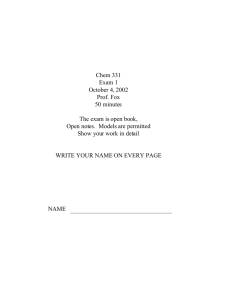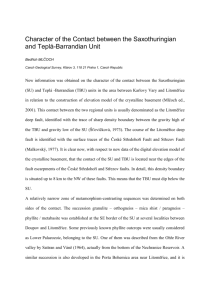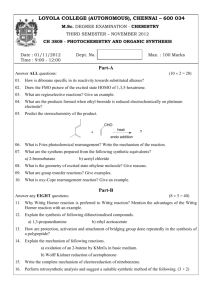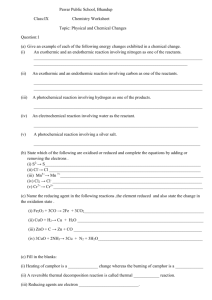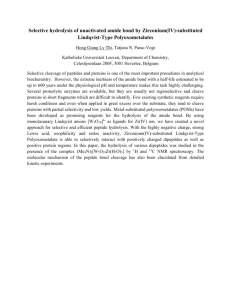Peptide Fragment Coupling Using a Continuous-Flow Photochemical Rearrangement of Nitrones Please share
advertisement
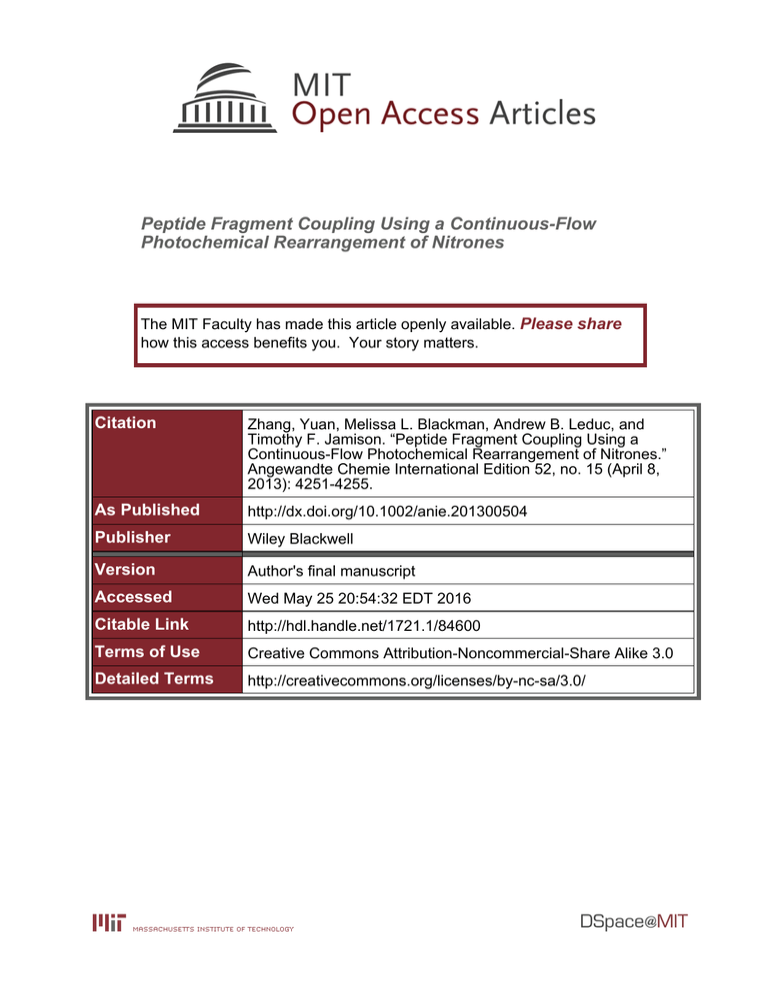
Peptide Fragment Coupling Using a Continuous-Flow Photochemical Rearrangement of Nitrones The MIT Faculty has made this article openly available. Please share how this access benefits you. Your story matters. Citation Zhang, Yuan, Melissa L. Blackman, Andrew B. Leduc, and Timothy F. Jamison. “Peptide Fragment Coupling Using a Continuous-Flow Photochemical Rearrangement of Nitrones.” Angewandte Chemie International Edition 52, no. 15 (April 8, 2013): 4251-4255. As Published http://dx.doi.org/10.1002/anie.201300504 Publisher Wiley Blackwell Version Author's final manuscript Accessed Wed May 25 20:54:32 EDT 2016 Citable Link http://hdl.handle.net/1721.1/84600 Terms of Use Creative Commons Attribution-Noncommercial-Share Alike 3.0 Detailed Terms http://creativecommons.org/licenses/by-nc-sa/3.0/ Continuous Flow DOI: 10.1002/anie.200((will be filled in by the editorial staff)) Peptide Fragment Coupling via Continuous Flow Photochemical Rearrangement of Nitrones** Yuan Zhang, Melissa L. Blackman, Andrew B. Leduc, Timothy F. Jamison* Amide bonds are prevalent in nature as the key chemical linkage of peptides and proteins and are also found in pharmaceutically relevant compounds and important synthetic polymers.[1] Conventional amide bond formation relies on condensation of carboxylic acids and amines and generally uses stoichiometric amounts of activating agents and other additives.[2] However, usage of activating agents in peptide synthesis can compromise their utility due to various drawbacks such as epimerization, high cost, and waste generation.[2b,3] In addition, despite the power of native chemical ligation (NCL) strategies for fragment assembly of polypeptides,[4] their reliance on the presence of N-terminal cysteine residues limits broader application and suggests a need for alternative amide bond formation processes.[2a] Toward this goal, we herein describe a continuous flow approach of amide bond construction that proceeds via photochemical rearrangement of a nitrone with stereochemical fidelity and, notably, is thus well suited for peptide fragment coupling (Scheme 1). Photochemical rearrangements of nitrone to oxaziridine,[5] and oxaziridine to amide[6] have been individually documented since the 1950s. However, there are only sporadic reports of one-pot photochemical rearrangement of nitrones to amides,[7] and to the best of our knowledge, no peptide bond formation using this approach has been described.[8] This photochemical amide bond formation process is attractive for several reasons, including: (1) obviation of stoichiometric activating agents or additives in nitrone formation from hydroxylamines and aldehydes,[9] (2) the ability to effect peptide ligation at a range of amino acid residues, and (3) telescoping of the often unstable oxaziridine intermediates.[6] In addition, by using a straightforward, easily assembled continuous flow reactor system,[10] the efficiency of this photochemical process is greatly enhanced. Continuous flow photochemical processes have established advantages over conventional batch transformations in reaction efficiency, yield, reproducibility, and material throughput. [11,12] In [] [] Dr. Y. Zhang, Dr. M. L. Blackman, Dr. A. B. Leduc, Prof. Dr. T. F. Jamison Department of Chemistry Massachusetts Institute of Technology Cambridge, MA 02139 (USA) Fax: (+1) 617-324-0253 E-mail: tfj@mit.edu We are grateful to the Novartis-MIT Center for Continuous Manufacturing for financial support. We thank several colleagues at MIT (Dr. Andrew S. Kleinke, Dr. James J. Mousseau, Dr. Ping Zhang, and Kurt Armbrust) and at Novartis (Dr. Guido Koch, Dr. Berthold Schenkel, Dr. Gerhard Penn, Dr. Benjamin Martin, and Dr. Jörg Sedelmeier) for insightful discussions. We also thank Eric Standley (MIT) and Li Li (MIT) for obtaining mass spectrometric data. Supporting information for this article is available on the WWW under http://www.angewandte.org or from the author. batch reactions, light penetration is limited to a narrow layer within the reaction mixture. Whereas in continuous flow setups, the narrower reaction channels and increased surface to volume ratio greatly enhance light absorption even at high substrate concentrations. High material throughput can be realized simply by flowing reaction mixture for a longer period of time. Furthermore, since the irradiation period can be precisely controlled by the flow rate, over-irradiation-related side reactions and decomposition pathways are often minimized or avoided altogether. Conventional Amide Bond Formation: O R1 NH2 amine + HO Stoichiometric Activating Reagents R2 O R1 Additives carboxylic acid R2 N H amide This work: R1 N H OH O + H Facile Condensation R2 hydroxylamine aldehyde R1 O N R2 hn Continuous Flow nitrone O R1 R2 N H amide Scheme 1. Photochemical Amide Synthesis The photochemical continuous flow reactor system that we constructed is depicted in Figure 1. Quartz tubing was placed around the water-cooled quartz immersion well of a 450 W mediumpressure mercury lamp. The reaction solution was introduced into the tubing using a syringe pump and collected into a flask after passing through a 20 psi back pressure regulator. The complete UV setup was operated safely within an aluminium foil-lined photobox that is easily accommodated by a standard laboratory fume hood.[13] Figure 1. Continuous Flow Photochemical Reactor We first tested the photochemical rearrangement of simple alkyl-aryl nitrone 1a in the continuous flow system. Nitrone 1a was readily prepared from methyl hydroxylamine hydrochloride and ptolualdehyde.[14] MeCN was found to be optimal among the solvents evaluated (THF, MeCN, DMF, iPrOH, benzene) and was used as the reaction solvent for further study.[15] Optimization of the reaction conditions is summarized in Table 1. We initially chose 0.02 M as substrate concentration and used a cooling water bath to maintain the reaction temperature at 40 °C. With a residence time (tR) of 30 min, all the starting nitrone 1a was 1 consumed, whereas the oxaziridine intermediate 2a was not fully converted to the amide product 3a (Table 1, entry 1). The addition of catalytic amount of trifluoroacetic acid (TFA, 0.1 equiv) facilitated converting oxaziridine to amide,[16] and afforded nearly exclusive amide formation with a 30 min tR even at 0.05 M substrate concentration (entry 3). Removal of the cooling water bath resulted in a rise of the reaction temperature to 92 °C and further expedited amide formation (entry 5). Finally, increasing the amount of TFA to 0.25 equiv drove the reaction to completion with a 10 min tR and gave 3a in 93% isolated yield (entry 6). Further increasing the concentration led to diminished conversion (entry 7). Thus, 0.05 M was employed as the reaction concentration for further studies. Table 1. Photochemical Rearrangement of Nitrone 1a to Amide 3a Me N O Me hn Me N O hn Entry[a] 1 2 3 4 5 6[c] 7 Me O MeCN MeCN 1a NH Me 2a 3a Conc. (M) tR (min) TFA (equiv) Temp (°C) 0.02 0.02 0.05 0.05 0.05 0.05 0.1 30 30 30 10 10 10 30 0.1 0.1 0.1 0.1 0.25 0.25 40 40 40 40 92 92 92 Me Ratio (1a:2a:3a)[b] nd : nd : nd : 1 : nd : nd : 1 : 2 nd 1 11 1 nd 4 : : : : : : : 3 1 26 21 19 1 21 [a] All entries were conducted using a 0.625 mL quartz tubing with an inner diameter (i.d.) of 0.762 mm. [b] All ratios were determined by 1H NMR studies. “nd”: not detected. [c] 93% isolated yield of 3a. With these conditions in hand, a series of alkyl-aryl nitrone substrates were investigated (Table 2). In general, formation of amides from nitrones with either electron-rich or electron-poor aryl group proceeded smoothly with good to excellent isolated yields. Substrates with electron-rich aryl groups tended to require a shorter tR and in some cases did not require TFA to accelerate the subsequent rearrangement (Table 2, entries 1-3, 9). Encouraged by the feasibility of photochemical rearrangement of alkyl-aryl nitrones to form amides, we next investigated peptide bond formation employing this transformation. Nitrone 6 was readily synthesized from Ala-derived hydroxylamine 4 and Valderived aldehyde 5 (Scheme 2).[14,17] Me OH NH (COOH)2 + H O tBu O Me Me O N O O TFA (equiv) Yield (%) 1 2 3 4 5 6[b] 7 8 9 10 1b 1c 1d 1e 1f 1g 1h 1i 1j 1k Me Me Me Me Me Me Me Me Bn Bn p-OMe m-OMe 3,4-(OCH2O) o-Me 2,4,6-Me p-Br p-F p-CF3 p-OMe p-Me 10 15 5 15 10 20 15 10 10 10 0.1 0.25 0.25 0.25 0.25 0.1 0.25 83 70 74 60 65 90 84 81 87 89 [a] All entries were conducted using a quartz tubing (0.460 mL or 0.625 mL, i.d. = 0.762 mm). Please see supporting information for details. [b] A Pyrex sleeve (280 nm cutoff) was placed around the UV lamp to prevent debromination. N O Me 7a O Me hn NHCbz Me Me NHCbz Me hn Me O tBu 6 tR (min) NHCbz Me 6 O Me R2 O Me Table 3. Photochemical Rearrangement of Nitrone 6 tBu R1 tBu RT, 67% Me O N When a 0.05 M solution of nitrone 6 in MeCN was subjected to the continuous flow photochemical conditions, the rearrangement was facile and neither TFA nor heating was required to promote the reaction (Table 3). Entries 1-4 demonstrate the reaction outcome with different residence times. The oxaziridine intermediate from nitrone 6 existed as a 3:2 mixture of two diastereomers 7a and 7b. The stereochemistry of the oxaziridine rings in 7a and 7b was tentatively assigned as shown. A 10 min tR was sufficient for full conversion of both the starting nitrone and the oxaziridine intermediates, and dipeptide 8 was isolated in 59% yield (Table 3, entry 4). In comparison, the corresponding batch reaction with 10 min reaction time only gave a mixture of oxaziridines and amide in 7:1 ratio (entry 5). Concentration is paramount in photochemical transformations according to the Beer-Lambert law, and a clean reaction is rarely obtained at a preparatively useful concentration such as 0.1 M in batch processes.[18] We were thus pleased to find that increasing the initial substrate concentration to 0.1 M required only a marginally longer residence time (12.5 min) for complete conversion, and more importantly, no detrimental effect on isolated yield of 8 was observed (entry 7). It is important to note that no epimerization on either stereogenic center in dipeptide 8 was observed by 1H NMR or HPLC analysis.[13] tBu Nitrone NHCbz O Scheme 2. Synthesis of Nitrone 6 Table 2. Substrate Scope for Rearrangement of Alkyl-Aryl Nitrones Entry[a] Et3N, CH2Cl2 O 5 Me 4 Me O O tBu O H N Me N O Me 7b NHCbz Me NHCbz O 8 Entry[a] tR (min) Conc. (M) Ratio (6:7:8)[b] Note 1 2 3 4 5[c] 6 7 1 2.5 5 10 10 12.5 0.05 0.05 0.05 0.05 0.05 0.1 0.1 1 : 9 :1 nd : 4 : 3 nd : 1 : 5 nd : nd : 1 nd : 7 : 1 nd : 1 : 6 nd : nd : 1 7a:7b = 3:2 59% isolated yield of 8 Batch, 10 min 59% isolated yield of 8 [a] All entries were conducted in MeCN at 40 °C using a quartz tubing (0.625 mL, i.d. = 0.762 mm). [b] All ratios were determined by 1H NMR studies. “nd”: not detected. [c] Batch reaction was conducted in a quartz NMR tube (i.d. = 5 mm) placed next to the quartz tubing. 2 Interestingly, in the rearrangement of nitrone 6, another amide (11) was isolated in 20% yield along with the desired dipeptide 8. The mechanism of formation of 11 is proposed in Scheme 3.[8b,19] Upon irradiation, homolytic cleavage of the weak N–O bond in the oxaziridine intermediate generates N,O-diradical 9. H-migration leads to the desired amide (8), while migration of the alkyl group gives aminal 10, which further degrades to amide 11. The ratio of 8 and 11 remains constant throughout the course of the reaction. It is also worth noting that similar by-products were not observed in photochemical rearrangement of alkyl-aryl nitrones 1a-k. Me O tBu N O Me O Me NHCbz H 7a/b hn tBu Table 4. Photochemical Formation of Dipeptides from Nitrones Me O Me Me H N O N O NHCbz H-migration tBu Me O H O Me 9 Me Entry[a] O O 8 (59%) O tBu O tBu N O Me 10 1 hn Me Me NHCbz O tBu degradation O H N O N O Me O 11 (20%) O tBu O N O Me O Me N O Me O Me hn NHCbz 10 min tR, 40 oC, 0.05 M in MeCN NHCbz 8 + 11 1.4 : 1 tBu 3 O N O H N O Me NHCbz O 13 (54%) O tBu N Cbz H N O Me O N Cbz 15 (60%) 14 The formation of 11 is somewhat surprising, because both previously reported theoretical studies[20] and experimental data[21] suggest that only the substituent anti to the nitrogen lone pair migrates in this process. Since nitrone 6 exists exclusively as its Zstereoisomer,[22] one would expect that both oxaziridine 7a and 7b to be trans-substituted. In both cases, therefore, H should be at the anti position and migrate selectively. To understand the stereochemical course of the rearrangement better, 7a and 7b were prepared from epoxidation of the corresponding imine and separated chromatographically.[8b,23] When 7a and 7b were subjected individually to the photochemical conditions, each provided a mixture of 8 and 11, however in different ratios (Scheme 4). This information together with previous theoretical study that substituent anti to nitrogen lone pair migrates with no significant activation barrier[20] prompts us to propose that nitrogen inversion in the oxaziridine ring competes with N–O bond cleavage in this process. The difference between the selectivity of 7a and 7b could be explained by disparate rates of nitrogen inversion due to different spatial environments. Further investigation and efforts to increase the rearrangement selectivity are currently ongoing. OtBu O tBu 12 H Scheme 3. Proposed Mechanism of Formation of 11 O OtBu Me 2 tBu Product[b] Substrate NHCbz Alkyl-migration H Next, a broader range of dipeptide formation was investigated (Table 4). All nitrones starting materials were readily synthesized from corresponding hydroxylamines and aldehydes.[14,17] Although we had demonstrated that initial substrate concentration could be as high as 0.1 M (Table 3, entry 7), substrate solubility in MeCN limited some to 0.05 M. All substrates proceeded smoothly under continuous flow photochemical conditions to give the corresponding dipeptide in reasonable to good yields. The rearrangement reaction tolerated a variety of functional groups. Nitrones derived from protected amino acids with hydrophobic side chains (Val, 6), polar uncharged side chains (Ser, 12), aromatic rings (Tyr, 18), charged side chains (Lys, 16; Glu, 20; and Arg, 22), and proline (14) are all amenable substrates for this transformation. Amide 11 was observed in all entries with isolated yields ranging from 10-19%.[13] O NHCbz tBu NHCbz Me Me NHCbz H N O 16 NHCbz O 17 (56%) OMe O tBu 4 O N O OMe O tBu NHCbz H N O Me Me 18 O tBu 5[c] O O N 19 (50%) OBn OBn O tBu O NHBoc O Me 20 6[d] tBu O NHCbz NH O tBu O Cbz N NHCbz H N Me Me 22 O 21 (50%) Cbz N NHCbz O N O NHBoc N Me O NHCbz O NHCbz NH O 23 (37%) [a] All entries were conducted at 0.05 M in MeCN at 40 °C with 10 min tR using a quartz tubing (0.460 mL or 0.625 mL, i.d. = 0.762 mm) unless otherwise noted. Please see supporting information for details. [b] Isolated yields were listed in parenthesis. [c] A 5 min tR was used. [d] The experiment was conducted in benzene with a 20 min tR. 7a O tBu O Me N O Me 7b Me hn NHCbz 10 min t , 40 oC, 0.05 M in MeCN R 8 + 11 5:1 Scheme 4. Individual Photochemical Rearrangement of 7a and 7b. S-protected cysteine-derived nitrones (S-Bn, S-tBu, S-trityl) are not suitable substrates in this transformation due to decomposition of the oxaziridine intermediates,[24] Despite this limitation, the substrate scope of this photochemical process represents a high degree of complementarity to NCL and can effect peptide fragment coupling at a much broader range of amino acid residues. To expand the scope of this photochemical peptide bond formation process further, sterically hindered nitrones 24 and 26 were prepared.[14,25] Upon irradiation, dipeptides 25 and 27 were 3 obtained without compromised yields, albeit longer residence times were required (Scheme 5). O tBu O O N Me Me 24 O tBu O 0.05 M in MeCN, 54% H N Me Me O N Cbz 25 O tBu O hn, 12.5 min tR, 40 oC N Cbz O Me Me N NHCbz Me Me 26 hn, 15 min tR, 40 oC O tBu 0.05 M in MeCN, 53% O H Me Me N NHCbz Me Me O We next investigated the formation of a longer peptide (Scheme 6). Nitrone 30 was prepared from Val-Gly-derived hydroxylamine 28 and Phe-Ala-derived aldehyde 29.[14,17] When a solution of 30 (0.05 M in MeCN) was subjected to the described photochemical conditions (tR = 10 min), tetrapeptide 31 was isolated in 52% yield. O O Me 28 Me H N O H + O NHCbz N H O O O [2] [3] [4] [5] [6] [7] 0.05 M in MeCN, 52% Ph O N H O Me Me Me hn, 10 min tR, 40 oC NHCbz [1] RT, 90% Ph H N Keywords: amide · continuous flow · nitrone · peptide · photochemical 30 H N O CH2Cl2 29 N O O Me Me tBu NH OH Ph O tBu Me H N O Received: ((will be filled in by the editorial staff)) Published online on ((will be filled in by the editorial staff)) 27 Scheme 5. Sterically Hindered Peptide Bond Formation tBu complex peptide bonds. Importantly, this transformation represents a novel approach for peptide fragment coupling and expands the current scope of protein synthesis. In addition, by adopting a continuous flow setup, the efficiency of the photochemical process can be significantly enhanced. Further investigations on its applications in cyclic peptide synthesis and protein ligation are currently ongoing. H N NHCbz [8] O Me 31 Scheme 6. Formation of Tetrapeptide 31 from Nitrone 30 [9] [10] The double photochemical rearrangement of bis-nitrone 33 also proceeded smoothly, giving the symmetrical diamide 34 in 49% yield (Scheme 7).[26] This result suggests that this transformation might find applications in protein engineering to create multifunctional chimeric proteins.[27] O tBu OH NH (COOH)2 O Me O O N O Et3N, CH2Cl2, H2O H 4 RT, 90% 32 Me tBu O + H [11] [12] Me O O H O N H hn, 12.5 min tR, 40 oC tBu O 0.05 M in MeCN, 49% 33 Me tBu O O N H O O 34 [13] [14] Me N H O tBu O [15] Scheme 7. Photochemical Bidirectional Amide Bond Formation [16] [17] [18] In conclusion, we have demonstrated a general and versatile approach for amide bond formation via continuous flow photochemical rearrangement of nitrones. Not only can the method be used to synthesize simple amides, but also to generate more [19] [20] The Amide Linkage: Structural Significance in Chemistry, Biochemistry, and Materials Science (Eds.: A. Greenberg, C. M. Breneman, J. F. Liebman), John Wiley & Sons, Hoboken, NJ, 2002. For recent reviews on amide bond synthesis, see: a) V. R.; Pattabiraman, J. W. Bode, Nature 2011, 480, 471–479; b) E. Valeur, M. Bradley, Chem. Soc. Rev. 2009, 38, 606–631. R. B. Merrifield, J. Am. Chem. Soc. 1963, 85, 2149–2154. P. E. Dawson, T. W. Muir, I. Clarklewis, S. B. H. Kent, Science 1994, 266, 776–779. J. S. Splitter, M. Calvin, J. Org. Chem. 1958, 23, 651–651. J. S. Splitter, M. Calvin, J. Org. Chem. 1965, 30, 3427–3436. Representative examples of nitrone to amide rearrangement: a) H. Kondo, K. Tanaka, K. Kubo, T. Igarashi, T. Sakurai, Heterocycles 2004, 63, 241–247; b) Y. Zeng, B. T. Smith, J. Hershberger, J. Aubé, J. Org. Chem. 2003, 68, 8065–8067; c) E. Bourguet, J.-L. Baneres, J.P. Girard, J. Parello, J.-P. Vidal, X. Lusinchi, J.-P. Declercq, Org. Lett. 2001, 3, 3067–3070. To the best of our knowledge, there are only two examples of related peptide formation from oxaziridines. See: a) P. Duhamel, B. Goument, J.-C. Plaquevent, Tetrahedron Lett. 1987, 28, 2595–2596; b) S. Wenglowsky, L. S. Hegedus, J. Am. Chem. Soc. 1998, 120, 12468– 12473. J. W. Bode, Top Organomet. Chem. 2013, 44, 13–34. For recent reviews on continuous flow, see: a) D. Webb, T. F. Jamison, Chem. Sci. 2010, 1, 675–680; b) S. V. Ley, I. R. Baxendale, CHIMIA 2008, 29, 162–168; c) K. Geyer, T. Gustafsson, P. H. Seeberger, Synlett, 2009, 15, 2382–2391; d) R. L. Hartman, J. P. McMullen, K. F. Jensen, Angew. Chem. 2011, 123, 7642–7661, Angew. Chem., Int. Ed. 2011, 50, 7502–7519. For recent reviews on photochemistry in continuous flow, see: a) M. Oelgemöller, O. Shvydkiv, Molecules 2011, 16, 7522–7550; b) J. P. Knowles, L. D. Elliott, K. I. Booker-Milburn, Beilstein J. Org. Chem. 2012, 8, 2025–2052. For contributions to this field from our laboratories, see: a) A. C. Gutierrez, T. F. Jamison, J. Flow Chem. 2011, 1, 24–27; b) A. C. Gutierrez, T. F. Jamison, Org. Lett. 2011, 13, 6414–6417; c) B. Shen, M. W. Bedore, A. Sniady, T. F. Jamison, Chem. Commun. 2012, 48, 7444–7446; d) J. W. Tucker, Y. Zhang, T. F. Jamison, C. R. J. Stephenson, Angew. Chem. 2012, 124, 4220–4223; Angew. Chem., Int. Ed. 2012, 51, 4144–4147. Please see supporting information for details. S. I. Medina, J. Wu, J. W. Bode, Org. Biomol. Chem. 2010, 8, 3405– 3417. Benzene is also an amenable solvent, albeit reaction rate is slower relative to MeCN. D. Xing, X. Xu, L. Yang, Synthesis 2009, 20, 3399–3404. A. Moulin, J. Martinez, J.-A. Fehrentz, J. Pept. Sci. 2007, 13, 1–15. A. Albini, L. Germani, Photochemical Methods, in Handbook of Synthetic Photochemistry (Eds.: A. Albini, M. Fagnoni), WILEYVCH, Weinheim, 2010. W. D. Emmons, J. Am. Chem. Soc. 1957, 79, 5739–5754. E. Oliveros, M. Rivière, J. P. Malrieu, C. Teichteil, J. Am. Chem. Soc. 1979, 101, 318–322. 4 [21] A. Lattes, E. Oliveros, M. Rivière, C. Belzecki, D. Mostowicz, W. Abramskj, C. Piccinni-Leopardi, G. Germain, M. Van Meerssche, J. Am. Chem. Soc. 1982, 104, 3929–3934. [22] A. G. Dias, C. E. V. Santos, F. Z. G. A. Cyrino, E. Bouskela, P. R. R. Costa, Bioorg. Med. Chem. 2009, 17, 3995–3998. [23] Please see supporting information for the synthesis of 7a and 7b. The stereochemistry was assigned in accordance with Table 3. [24] It is known that thioethers can react with oxaziridines, leading to either N- or O-transferred products. See: A. Armstrong, I. D. Edmonds, M. E. Swarbrick, Tetrahedron Lett. 2003, 44, 5335–5338. [25] J. Calveras, M. Egido-Gabás, L. Gómez, J. Casas, T. Parella, J. Joglar, J. Bujons, P. Clapés, Chem. Eur. J. 2009, 15, 7310–7328. [26] For recent examples of bi-directional approach in organic synthesis, see: a) Y. Zhang, J. D. Rainier, Org. Lett. 2009, 11, 237–239; b) V. B. Naidoo, M. Rautenbach, J. Pept. Sci. 2012, 18, 317–325. [27] For recent reviews on protein linkers, see: a) P. E. Wright, H. J. Dyson, Curr. Opin. Struct. Bio. 2009, 19, 31–38; b) W. Wriggers, S. Chakravarty, P. A. Jennings, Biopolymers 2005, 80, 736–746. 5 Continuous Flow Dr. Yuan Zhang, Dr. Melissa L. Blackman, Dr. Andrew B. Leduc, Prof. Dr. Timothy F. Jamison* __________ Page – Page Peptide Fragment Coupling via Continuous Flow Photochemical Rearrangement of Nitrones R1 O N R2 MeCN R1 0.05 M H N R2 O Amide Nitrone hn 50-93% Continuous Flow tR ≤ 20 min A general approach for amide bond formation via continuous flow photochemical rearrangement of nitrones was described. Simple aryl-alkyl amide bonds as well as complex peptide bonds can be constructed efficiently with a residence time (t R) less than 20 min. A tetrapeptide was synthesized using the described method to demonstrate potential applications in peptide fragment coupling. 6
